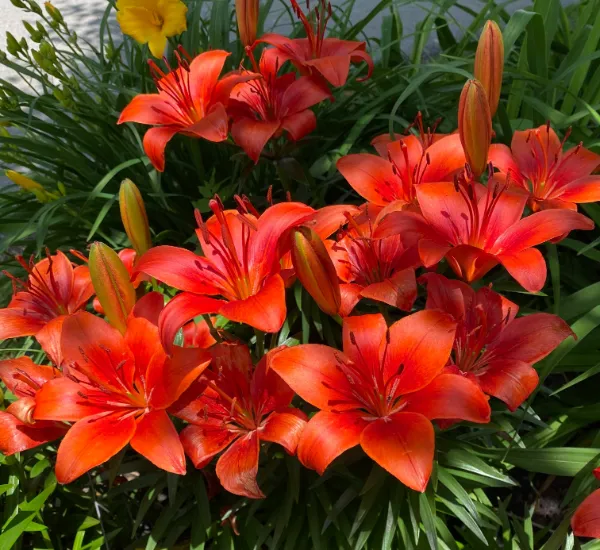Asiatic Lily: Everything You Need to Know
Welcome to the enchanting world of Asiatic lilies! Discover the ins and outs of these stunning, easy-care perennials that will elevate your garden to new heights. From their vibrant colors and unique characteristics to planting tips and varieties,
Our comprehensive guide has everything you need to know. Dive in and get ready to transform your outdoor space with these breathtaking beauties!
Asiatic Lily: The Highlight of the Summer Garden

- Range of colors: Asiatic lilies come in a veritable rainbow of colors, from vibrant reds, yellows, and oranges to more subtle purples, pinks, and whites. There are even some dramatic bi-color varieties out there for those who like to make a bold statement in their garden.
- Bloom clusters at the top of the plant: One of the most eye-catching aspects of Asiatic lilies is their bloom clusters. The flowers appear at the very top of the plant, making them perfect for cutting gardens and adding a pop of color to your home.
- Ideal for cutting gardens: Speaking of cutting gardens, Asiatic lilies are a top choice for those who love to bring the outdoors in. Their tall stems and stunning blooms make for gorgeous bouquets that will brighten up any room.
- Plant height and growth habits: Asiatic lilies typically grow to be about 18 to 24 inches tall. They form from bulbs, which get bigger and better every year, making them a fantastic investment for your garden.
- Bulb formation and improvement over time: As mentioned earlier, Asiatic lilies grow from bulbs, which means they’ll come back year after year. The bulbs will continue to grow and multiply, so you’ll have more gorgeous flowers each time they bloom.
- Deer resistance: One of the best things about Asiatic lilies is that they’re relatively deer resistant. This means you can enjoy their beauty without having to worry about pesky deer munching on your precious blooms.
Growing Conditions and Care for Asiatic Lilies
Ideal Planting Locations
- Sun requirements: Asiatic lilies love the sun, so be sure to tuck them into open, sunny spots in your garden. They’ll need at least six hours of sunlight per day to thrive.
- Soil preferences: When it comes to soil, Asiatic lilies prefer well-draining soil with a slightly acidic pH level. They’ll tolerate a wide range of soil types, but make sure to avoid heavy clay or overly wet soil, as this can cause the bulbs to rot.
Planting Tips
- Proper spacing: When planting your Asiatic lily bulbs, make sure to space them about 8 to 12 inches apart. This will give them enough room to grow and ensure a beautiful display come summertime.
- Depth of planting: To plant your bulbs, dig a hole about 4 to 6 inches deep and place the bulb with the pointed end facing upwards. Cover the bulb with soil and water well to help it settle in.
Here you can step by step guideline about How to Plant Asiatic Lilies
Watering and Fertilizing Needs
Asiatic lilies need consistent moisture, but be careful not to overwater them. Water them deeply and regularly, allowing the soil to dry out slightly between waterings.
As for fertilizing, a slow-release, balanced fertilizer applied in the spring should do the trick.
Pest and Disease Management
While Asiatic lilies are relatively low-maintenance, they can be susceptible to some pests and diseases. Keep an eye out for aphids, lily beetles, and slugs, and take action if you notice any signs of infestation.
To prevent diseases like root rot and fungal infections, make sure your lilies have proper air circulation and well-draining soil.
Know in Depth, watch this Video
Asiatic Lily Varieties
- Popular Asiatic lily hybrids: There are numerous Asiatic lily hybrids available, each with its unique charm. Some popular choices include ‘Connecticut King’ (bright orange), ‘Monte Negro’ (deep red), and ‘Navona’ (pure white).
- Unique bi-color varieties: For those who love a little extra flair, there are also stunning bi-color varieties like ‘Tiny Sensation’ (yellow and red) and ‘Lollipop’ (white and pink). These striking combinations will undoubtedly make a statement in your garden.
- Choosing the right variety for your garden: When selecting Asiatic lily varieties, consider the overall color scheme and style of your garden. Don’t be afraid to mix and match colors and textures for a dynamic and visually appealing display.
Using Asiatic Lilies in Your Garden Design
- Border and accent plantings: Asiatic lilies make beautiful border and accent plants. Their height and vibrant blooms can add depth and interest to any garden bed or border.
- Cutting gardens: As mentioned earlier, Asiatic lilies are perfect for cutting gardens. Plant them in a dedicated space where you can easily access them for creating stunning bouquets.
- Companion plants: When choosing companion plants for your Asiatic lilies, consider plants with contrasting textures and colors. Some excellent options include hostas, ferns, and ornamental grasses.
Propagating Asiatic Lilies
- Dividing bulbs: To propagate Asiatic lilies, you can divide the bulbs in the fall. Carefully dig up the bulbs, separate the offsets (baby bulbs) from the main bulb, and replant them in a new location.
- Growing from seeds: Alternatively, you can grow Asiatic lilies from seeds, although this method can be more time-consuming. Collect seeds from mature plants, and sow them in a well-draining soil mix. Keep the soil moist and warm, and be patient – it may take several weeks for the seeds to germinate.
- Tips for successful propagation: Regardless of the propagation method you choose, remember to provide your new lily plants with proper care, including adequate sunlight, water, and fertilizer.
Are Asiatic Lilies Safe for Pets?
Many pet owners are concerned about whether Asiatic lilies are toxic to dogs and other pets. The answer is yes – Asiatic lilies are toxic to dogs and cats. Ingesting any part of the plant can cause vomiting, lethargy, and loss of appetite in pets.
In severe cases, it can even cause kidney failure and death. Therefore, it’s important to keep Asiatic lilies away from your pets at all times.
Is Asiatic Lily Poisonous to Dogs?
As we mentioned above, Asiatic lilies are toxic to dogs. The toxins in the plant can cause serious health problems, so it’s important to be aware of the signs of lily poisoning in dogs.
Symptoms include vomiting, diarrhea, lethargy, loss of appetite, and increased urination. If you suspect that your dog has ingested any part of an Asiatic lily, it’s important to seek veterinary attention immediately.
Read My Full Article about: Is Asiatic Lily Poisonous to Dogs?
Precautions to Keep Pets Safe from Asiatic Lilies
To keep your pets safe from Asiatic lilies, it’s important to take a few precautions. First, avoid planting Asiatic lilies in areas where your pets have access to them. If you do decide to plant Asiatic lilies in your garden, make sure they are in a fenced-off area where your pets cannot reach them.
You should also be careful when bringing Asiatic lilies into your home. Make sure they are placed in an area where your pets cannot access them, and dispose of any fallen petals or leaves immediately.
Wildlife and Asiatic Lilies
While Asiatic lilies are toxic to pets, they are not usually a preferred food source for wildlife such as rabbits and deer. In general, these animals will avoid eating lilies, as they have a bitter taste and are not as appealing as other types of plants. However, in times of food scarcity, wildlife may resort to eating Asiatic lilies if there are no other options available.
Do Rabbits Eat Asiatic Lilies?
Rabbits are known to be voracious eaters, but they typically do not eat Asiatic lilies. While rabbits may nibble on the leaves or stems of lilies, they will usually not consume the entire plant.
In general, rabbits prefer to eat grasses and other types of plants that are easier for them to digest.
Read My Full Article about: Do Rabbits Eat Asiatic Lilies?
Will Deer Eat Asiatic Lilies?
Deer are also unlikely to eat Asiatic lilies. While deer are known to eat a wide variety of plants, they tend to avoid lilies due to their bitter taste.
However, in areas where food is scarce, deer may eat Asiatic lilies if there are no other food sources available.
Read My Full Article about: Will Deer Eat Asiatic Lilies
FAQs
When do Asiatic lilies bloom?
Asiatic lilies typically bloom in early to mid-summer, providing a burst of color when many other plants have yet to flower.
Are Asiatic lilies toxic to pets?
Yes, Asiatic lilies are toxic to cats and can cause severe kidney damage if ingested. If you have cats, it’s best to keep Asiatic lilies out of reach or consider planting a different, non-toxic species.
How do I overwinter Asiatic lily bulbs in colder climates?
In colder climates, you can protect your Asiatic lily bulbs by applying a thick layer of mulch over the planting area once the ground has frozen. This will insulate the bulbs and help prevent them from freezing.
Can Asiatic lilies be grown in containers?
Absolutely! Asiatic lilies can be successfully grown in containers, provided they have adequate drainage and are placed in a sunny location.
Conclusion
So there you have it – a comprehensive guide to the beautiful and versatile Asiatic lily. With their easy-care nature and stunning blooms, these flowers are a fabulous addition to any garden.
Why not give them a try and see for yourself? And don’t forget to share your experiences and tips in the comments below. Together, we can cultivate a community of passionate gardeners who can learn from and inspire one another.
Happy gardening, my fellow flower lovers! May your gardens be filled with the vibrant colors and captivating beauty of Asiatic lilies. Remember, sometimes it’s the little things in life that can bring the most joy, and these delightful flowers are the perfect example of that.
So, go ahead and add a touch of magic to your outdoor space, and let the enchanting world of Asiatic lilies sweep you off your feet!






